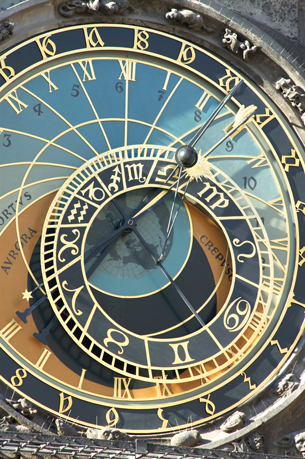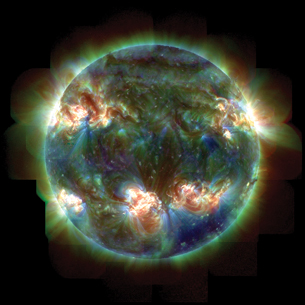Module 5—Circular Motion
 Reflect and Connect
Reflect and Connect

© Olga Shelego/shutterstock
Astronomy continues to be a field that attracts many scientists, as does the exploration of space. Throughout history, there have been numerous inventions that either relied on astronomy or aided in the study of astronomy and space. Kepler’s laws accurately describe the motion of the planets. Based on similar principles, other astronomical devices were designed based on the predictable motion of the heavens and Earth’s motion within it. Consider the sundial that relies on the relative position of the Sun to keep accurate time. Another invention related to the periodic motion of the solar system was the astronomical clock (pictured on the left). This clock has special mechanisms to accurately display the relative position of the Sun, Earth, and Moon at any given time. The first astronomical clocks were produced 300 years before Kepler’s time. They instantly gained appeal because they represented a philosophical position that the motion of celestial objects, such as the Moon, were ordered and part of a heavenly ordained universe. Since Galileo worked with the telescope in the seventeenth century, the telescope has undergone major changes and is now one source that provides scientists with high-quality, reliable data.
Here is an ultraviolet image of the Sun’s active photosphere (the visible surface of the star), captured by the TRACE space telescope. This image contains details that were unimaginable in Kepler’s time.
Leading-edge astronomy is no longer performed from a hilltop with an optical telescope.
 Discuss
Discuss

Courtesy of TRACE, Stanford Institute, NASA
In the discussion forum, post a general overview of one of the vast number of astronomical data-collection technologies currently being used. Describe the purpose and type of astronomical data that is being collected. Remember, the technology can be found on Earth’s surface, in orbit beyond Earth’s atmosphere, or in transit to places beyond the solar system.
You can use the following table to evaluate your overview.
| 4 | 3 | 2 | 1 | ||
| Describing Technology | One technology is described in detail. | One technology is described, but the purpose or type of data being collected is weak. | One technology is described, but the purpose or type of data being collected is missing. | One technology is described briefly. | ___ |
| Information Gathering | Information is gathered from multiple sources and cited properly. | Information is gathered from multiple sources but not cited. | Information is gathered from limited sources and cited properly. | Information is gathered from limited sources and not cited. | ____ |
| Summary Paragraph | Paragraphs are well organized and demonstrate logical sequencing and sentence structure. | Paragraphs are well organized, but demonstrate illogical sequencing or sentence structure. | Paragraphs are well organized, but demonstrate illogical sequencing and sentence structure. | Paragraphs are weakly organized. | ____ |
| Total | ____ |
 Reflect on the Big Picture
Reflect on the Big Picture
Each of the Reflect on the Big Picture sections in this module will ask you to consider the movement of objects in a circle or part of a circle. Complete at least one of these reflection activities:
- Research and develop a timeline showing the major milestones in humanity’s understanding of the paths of the planets.
- Research one of the early descriptions of planetary motion. (Be sure to identify the scientist who gave the description.) Based on what you have studied, can you identify one or two flaws in the description?
Store your completed reflection in your Physics 20 Course Folder.
 Module 5: Lesson 3 Assignment
Module 5: Lesson 3 Assignment
Remember to submit the Module 5: Lesson 3 Assignment to your teacher.